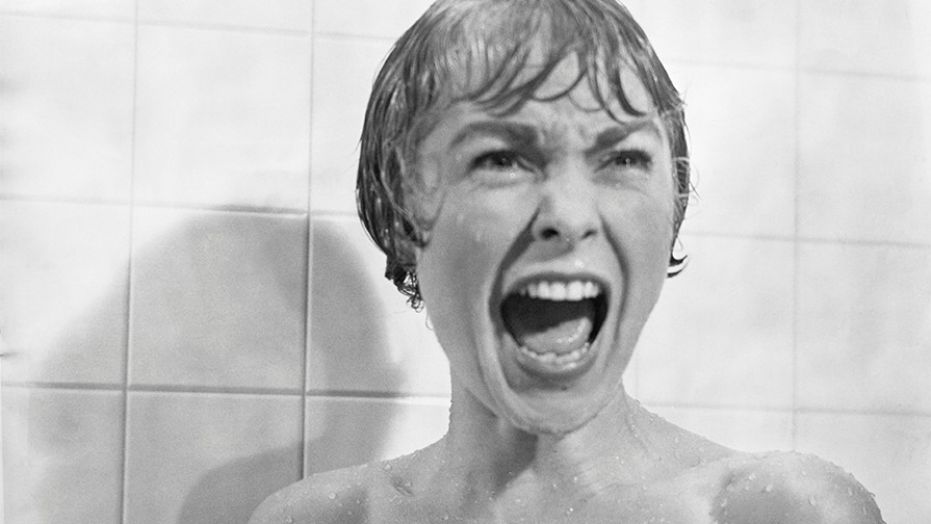Blueprints: "Psycho"
 Thursday, April 5, 2018 at 11:00PM
Thursday, April 5, 2018 at 11:00PM The April Showers series is back at The Film Experience, here's Jorge on how the most famous shower scene in cinema histor was written on the page.

One thing about iconic cinema sequences is that back when the script is written, before the movie is shot, released and gains critical acclaim (sometimes before it is even developed), they are not conceived to be iconic. They are simply a piece in a puzzle; one more segment in a longer story.
But sometimes sequences transcend. Sometimes they become essential pieces of the cinema mosaic. And few scenes have stood the test of time better than the shower scene in Psycho. It has been recreated countless times, spun hundreds of homages and parodies, and changed the way horror scenes are shot, and what audiences should expect of the genre. Let’s take a look at how it looked in the page, before it acquired icon status, when it was merely three pages of a script…
Psycho
Written by: Joseph Stefano
Based on the novel of the same name by Robert Bloch
[You can read the full script here. I will be talking about these pages and this scene.]
Psycho was based on the then-popular pulp murder mystery by Robert Block, although by now the popularity of the film has now surpassed the book’s. However, the literary and prose origins of the story are evidenced all over the screenplay adaptation.
In the first paragraph of the sequence, “Mary” (who would later become Marion) counts the cash that she stole from her boss. It is only a few seconds of screen time, but the moment is described with overwhelming detail. It seems as if it was almost lifted from the pages of the book: “We see from these figures a calculation which indicates her intention to make a restitution of the money she has used of the forty thousand dollars.” It not only meticulously describes what’s written on her checkbook, but also the character’s thoughts and unsaid intentions. This script was meant to be read as well as shot.

However, screenwriter Joseph Stefano (probably being heavily influenced by Hitchcock, who carries most if not all of the film’s credit today), also acknowledges that this is not to be a purely literary product. It is something that will be translated (and eventually immortalized) in visual terms.
Mary/ Marion takes a shower, which is interrupted by the shadow of a woman entering the bathroom; she rips the shower curtain with a knife, and eventually murders Marion. This is a relatively simple series of movements and actions, but they are told with highly vivid imagery in the page.
The script describes these actions in small, elongated moments (“The door is then slowly and carefully closed. And we see the shadow of a woman fall across the shower curtain”). It mentions sound effects (“The noise of the shower drowns out any sound”), and important visual cues (“The blank whiteness, the blur of the shower water”). This is all done to build tension and create emotional escalation.

***

The script even goes into the details of a single shot: the now iconic trailing of the blood into the drain. It is basically a motionless tableau of Marion’s dead body as her blood runs through the tub’s porcelain, and the action describes everything, from the blocking and positioning of her limbs (“The head tumbled over, touching the floor, the hair wet, one eye wide open as if popped, one arm lying limp and wet along the tile floor), to the path that the camera ought to follow as we step away from her.
There is almost no dialogue in the entire sequence except for Norman’s off-screen, panicked screams at her mother. Everything is told in action, in visuals, and in detailed descriptions.

We will never know for sure if Stefano and Hitchcock felt that they were about to create one of the most important sequences in cinema while these pages were being written. But it is evident that there was a masterful balance of the literary and the visual in the descriptions; they understood the medium that they were using.
The sequence not only created tension for the person who was reading the script, but it also paved a carefully carved path for the filmmakers to follow once it was translated into film. Like a great blueprint should. *Cue string music*



Reader Comments (5)
One question: when they publish the sript for a movie, is it the original screenplay or the modified screenplay to incorporate all changes made when shooting it?
And coincidentally, 2001: A Space Odyssey and Psycho are my two favorite movies. Two articles about them in rapid succession yay!
Please let everyone know that Brazil is unjustly arresting its most popular president, LUIZ INÁCIO LULA DA SILVA. Coup d'etat, happening TODAY.
One of the great sequences in cinema - a masterwork of editing, and sound- Herrman's shrieking score- yes Hitchcock was a genius
its really Accepted work which you done.
shareit apk for pc